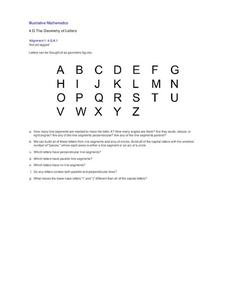Illustrative Mathematics
Oakland Coliseum
Help algebra learners relate a real-life function that happens at the Oakland Coliseum every time the Raiders play. The resource states that the revenue of the Oakland Raiders home games is a function of the number of seats sold and the...
Illustrative Mathematics
Waiting Times
Probability prevails in this assignment as youngsters determine the probability of finding a blue pen in a cereal box when they can come in blue, green, yellow, or red. Learners set up a simulation to determine the outcome of compound...
Illustrative Mathematics
Comparing Snow Cones
Everyone wants to have the biggest snow cone possible, so would that be in cone-shaped cup or a more cylinder-style cup? Hungry geometry juniors compute the volume of each in this practical task.
Illustrative Mathematics
What is a Trapezoid? (Part 1)
Challenge your class to construct a definition for trapezoids. Looking at four examples and four non-examples, students individually create definitions and use them to classify an unknown shape. Allow for small group and whole-class...
Illustrative Mathematics
Fractions and Rectangles
Visual models are excellent teaching tools when explaining equivalent fractions. Looking at a rectangle cut into twelfths, young scholars first identify the shaded fraction, and then explain whether the fraction is equal to one-fourth....
Illustrative Mathematics
Listing Fractions in Increasing Size
Increase the depth of your class's fractional number sense with this number-ordering activity. Given four fractions, each with different numerators and denominators, young learners are asked to place them in order from smallest to...
Illustrative Mathematics
Who is the Tallest?
A simple question, with a not-so-simple answer. Working with whole and mixed number measurements in inches, feet, and yards presents a problem with many possible solutions. A great activity that challenges the minds of young...
Illustrative Mathematics
Finding the Line of Symmetry
Can you find the line of symmetry? That's what your learners will demonstrate by completing this worksheet. The task gets increasingly difficult as shapes are included that have one line of symmetry, no lines of symmetry, and multiple...
Illustrative Mathematics
The Geometry of Letters
Use the alphabet as a tool for teaching your class about geometric figures. Break apart capital letters into line segments and arcs. Classify angles as right, acute, or obtuse. Identify parallel and perpendicular lines. An excellent...
Illustrative Mathematics
Price per Pound and Pounds per Dollar
Help learners understand the concept of unit rate as it is applied to buying beans at a grocery store. The objective is to determine the unit rate in two ways, and then apply each ratio to an additional problem. The attached commentary...
Illustrative Mathematics
Dividing by One-Half
Understanding when to divide by two or one-half can be confusing. Here is an activity that gives four different scenarios. It is up to your number crunchers to decide if they divide by two or one-half. The easiest way to approach the...
Illustrative Mathematics
What is a Trapezoid? (Part 2)
This collaborative activity investigates the meaning of a trapezoid and a parallelogram. It begins by presenting two different definitions of a trapezoid. Learners are to reason abstractly the difference between the two definitions and...
Illustrative Mathematics
Banana Pudding
Making banana pudding despite misplacing your one-cup measuring cup is easy as long as you can find your quarter-cup measuring cup! This real-life activity provides a good opportunity for learners to interpret division of a whole...
Illustrative Mathematics
Battle Ship Using Grid Paper
You sank my battleship! The iconic cry of the time-honored game, Battleship will be heard in classrooms with this learning game that requires only grid paper, pencils, and an introductory knowledge of the first quadrant of the coordinate...
Illustrative Mathematics
Pennies to Heaven
Even though pennies seem to be relatively thin, stack enough of them into a single stack, and you could have quite a high stack. Enough so, that the final result can be a surprise to you as well as your class. This activity centers...
Illustrative Mathematics
Random Walk III
Don't cross the line; just walk along it. Scholars investigate a scenario in which a person starts at zero on a number line, then moves left or right depending on a flip of a coin. They determine the number of outcomes for six flips,...
Illustrative Mathematics
Making 22 Seventeenths in Different Ways
There is more than one way to determine a sum. Scholars demonstrate their understanding of the decomposition of fractions similar to the decomposition of whole numbers. The short task requires pupils to determine which sums of fractions...
Illustrative Mathematics
Find 1 Starting from 5/3, Assessment Variation
Take two steps back. Given 5/3 on a number line, the task asks pupils to determine where one goes. The activity is the most demanding in cognitive complexity of three tasks dealing with the placement of fractions on a number line.
Illustrative Mathematics
Find 1/4 Starting from 1, Assessment Version
Where does a quarter go? Given a number line, the short task asks individuals to place the number one-fourth correctly upon it. The writers developed the task to demonstrate ways to assess critical skills from the CCSS.
Illustrative Mathematics
Hitting the Target Number
Make combinations to reach the target. Learners play a game to add and subtract numbers between 0 and 10 to reach a target number between 10 through 20. Teachers use the game to help pupils learn efficient ways to add and subtract within...
Illustrative Mathematics
Using Lengths to Represent Equality
Match the length in more than one way. Pupils work in pairs to create equal lengths using different combinations of rods. The quick activity allows learners to develop a physical understanding of equality and realize there is more than...
Illustrative Mathematics
Measuring Blocks
Stack them together to get a measurement. The short activity has pupils work in pairs to measure the lengths of two blocks and then determine the length of the two blocks together. The groups then determine an equation that represents...
Illustrative Mathematics
Find 7/4 Starting from 1, Assessment Variation
Practice working with number lines with a simple, versatile learning exercise. On a number line starting at zero and continuing beyond one, third graders decide where to place the fraction seven-fourths.
Illustrative Mathematics
Hand Span Measures
How long is your hand span? Young mathematicians measure their hand span from pinky tip to thumb tip using a centimeter ruler. After rounding to the nearest whole centimeter, learners plot their data on a line plot.

























